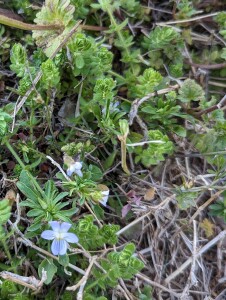 The best time to see woodland and woodland-edge wildflowers is in spring, and the best place to find them is in undisturbed areas in the country, or on the edges of urban or suburban parks or botanical gardens. Wildlife reserves are good too, as are nature trails.
The best time to see woodland and woodland-edge wildflowers is in spring, and the best place to find them is in undisturbed areas in the country, or on the edges of urban or suburban parks or botanical gardens. Wildlife reserves are good too, as are nature trails.
On vacation last week I hiked on a nature trail that was bounded on one side by a river and the other by woodland. Without even venturing off the trail, I saw at least a dozen wildflower species and varieties in the space of about 90 minutes. Among the most interesting were a relatively large species that I recognized right away and a smaller one that I am still at least a bit puzzled about.
The easily recognizable wildflower was common mayapple or Podophyllum peltatum. “Peltatum” means “umbrella-like”, an apt description of the large, palmate leaves that sit atop 12-inch stalks. Once mayapple foliage has unfurled in the spring, a good-sized toad could happily sit in the shade of an average size mayapple leaf.
Mayapples grow from fleshy underground roots or rhizomes and readily colonize the shady woodland edges they prefer. In the spring, those big leaves also hide something else—lovely white flowers with six to nine petals each surrounding centers of clustered yellow anthers. The shy flowers tend to droop a bit and are hard to spot unless you look carefully. Still, they are charming, and the plants are distinctive. Once pollinated, the flowers eventually give way to oval-shaped “apples”, which are, at least theoretically, edible. These days I suspect that with the exception of intrepid foragers, humans don’t eat them. Box turtles apparently do. Not surprisingly I saw at least 20 turtles congregating nearby at the river’s edge. Perhaps later in the summer those turtles will scrabble across the pedestrian path and feast on the “apples”.
While ogling the mayapples and searching for the elusive mayapple flowers, I saw groups of tiny flowers growing along the edges of the walking path. From above they looked like miniscule stars, but closer inspection revealed minute pansy=like faces, with the typical viola family petal array of “two up, three down”. I had not encountered anything like them in my wildflower travels closer to home. Perhaps I hadn’t looked in the right places at the right time. At any rate, I took a host of pictures with my phone’s camera to help my flower research.
The mystery flowers, which grew on two to six-inch stems, were clearly members of the large violet family, but bore leaves that were closer in appearance to those of the small-flowered violas that I buy from garden centers in the spring than those of the common wild violet—Viola soraria. Some gardeners love the sorarias and others hate them, but just about everyone can agree that they run rampant through country verges and suburban lawns at this time of the year. Viola soraria leaves are heart-shaped, with the flower stalks springing from a basal foliage rosette. The mystery plant’s leaves were elongated and appeared somewhat toothed.
My curiosity was piqued, and as soon as I returned to my hotel room, I started researching the lovely little violas with the dime-sized, pale blue or blue purple flowers. Each flower also had a touch of yellow at the heart and a few “whiskers” on the central lower petal.
Viola research can be difficult because the genus is large and far-flung. Viola species growing in proximity to each other also tend to interbreed. Still, horticultural curiosity is a powerful thing, and I was determined to put a name to my new viola acquaintance.
My first discovery was that while gallons of ink have been spilled in descriptions of Viola soraria, many fewer have been expended describing other violets. I looked at what seemed like hundreds of online images of violets from North America and elsewhere in the world. I saw lots of heart-shaped leaves. Finally, after tackling a formidable list of viola species I found one that looked like my mystery violet—Viola arvensis, the “European field pansy.” The fact that it looks more like what Americans call a “viola” and less like what Americans refer to as a “pansy”, is of no consequence. Viola arvensis is not native to these shores, but hails from Europe, Western Asia and North Africa. Clearly it jumped the fence from colonial-era gardens early on and made itself thoroughly at home.
Sometimes the European field pansy is also called “johnny jump-up”, because it pops up in unexpected places. When I was growing up the violas that we called “johnny jump-up” were from another species, the dark purple and yellow Viola tricolor, another naturalized European that is an ancestor of the modern hybrid pansy.
This is why common plant names are unreliable.
